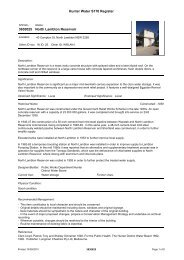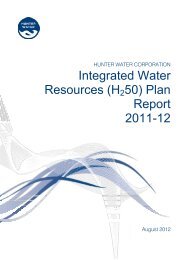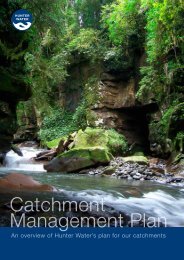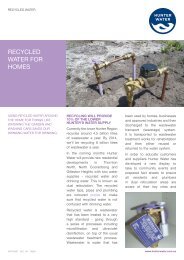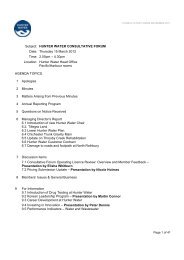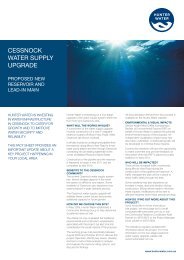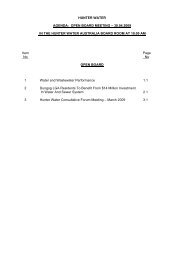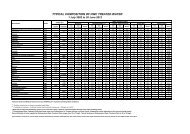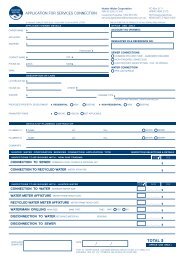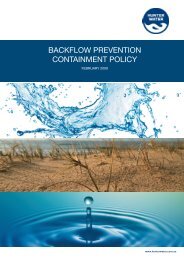Water Kit - Hunter Water
Water Kit - Hunter Water
Water Kit - Hunter Water
You also want an ePaper? Increase the reach of your titles
YUMPU automatically turns print PDFs into web optimized ePapers that Google loves.
managing water supply sustainably<br />
worksheet 3<br />
background<br />
The demand for a reliable and safe<br />
water supply brings with it a number<br />
of impacts. Environmental, social and<br />
economic considerations must be<br />
taken into account when managing<br />
water supply. Sustainability can be<br />
achieved by following Ecologically<br />
Sustainable Development (ESD)<br />
principles and objectives that ensure<br />
the maintenance of ecological<br />
processes and systems. The core<br />
objectives of the National Strategy for<br />
ESD are to:<br />
• Ensure economic well-being that<br />
safeguards the welfare of future<br />
generations (‘intergenerational<br />
equity’)<br />
• Enhance the individual and<br />
community well-being within<br />
and between generations<br />
(‘intragenerational equity’)<br />
• Conserve and protect biological<br />
diversity and essential ecological<br />
processes and life-support<br />
systems<br />
This worksheet involves students in<br />
research, reflection and problem-solving<br />
in response to a hypothetical situation<br />
concerning sustainable management of<br />
water supply in the <strong>Hunter</strong>.<br />
THE CURRENT SITUATION<br />
<strong>Hunter</strong> <strong>Water</strong> is responsible<br />
for supplying the Lower <strong>Hunter</strong><br />
community with a reliable and healthy<br />
supply of water. This includes urban<br />
residents and industry in Newcastle,<br />
Lake Macquarie, Maitland, Cessnock<br />
and Port Stephens. To meet the<br />
water demands of its customers,<br />
<strong>Hunter</strong> <strong>Water</strong> extracts water from<br />
four main sources: Chichester Dam,<br />
Grahamstown Dam, Tomago Sandbeds<br />
and the Tomaree Sandbeds, located<br />
in either the Williams River or Port<br />
Stephens catchments. The population<br />
of the Lower <strong>Hunter</strong> region is steadily<br />
growing, placing extra demand on the<br />
area’s water supplies. Some action<br />
will be needed to meet the additional<br />
demand, but every option has specific<br />
costs and benefits. These options must<br />
be fully considered in terms of ESD<br />
principles if we are to ensure sustainable<br />
management of the water supply.<br />
The hypothetical options<br />
Let’s say there are two main options to<br />
help address the growing demand on<br />
the <strong>Hunter</strong>’s water supplies:<br />
• Introduce widespread and<br />
effective water conservation<br />
measures in the Lower <strong>Hunter</strong><br />
• Build a dam across the Tillegra<br />
River, on gently sloping land that<br />
is a mix of grazing, dairy, native<br />
forests<br />
The activity<br />
Choose one or both of the hypothetical<br />
options outlined above and get your<br />
group to:<br />
• Discuss how population increases<br />
and lifestyle changes impact on<br />
water supply. Understanding what<br />
causes increased demand can<br />
help in developing preventative<br />
measures to manage demand on<br />
water supplies.<br />
• Identify the major elements of<br />
each hypothetical option. For<br />
example: What kind of measures<br />
to conserve water could be<br />
implemented? What would<br />
construction of a new dam<br />
involve?<br />
• Identify the key stakeholders<br />
associated with the option. For<br />
example: Who would be involved<br />
in the decision-making? Who will<br />
be affected by the option and<br />
therefore need to be consulted?<br />
• Identify the different viewpoints of<br />
stakeholders and assess whether<br />
they would generally be for,<br />
against, or neutral regarding the<br />
option.<br />
• Investigate the possible<br />
environmental, social and<br />
economic impacts of the option.<br />
• Propose possible alternatives<br />
to address conflict surrounding<br />
the option and address (ESD)<br />
principles.<br />
• Convene a public meeting (ie<br />
role play) where the proposal<br />
can be outlined and the views of<br />
the various stakeholders shared.<br />
Classroom consensus could be<br />
sought to determine whether<br />
or not the option has merit and<br />
therefore whether it should be (i)<br />
implemented, (ii) modified, or (iii)<br />
overturned.<br />
<strong>Water</strong> kit . ssS . 001 . april 2010<br />
30




